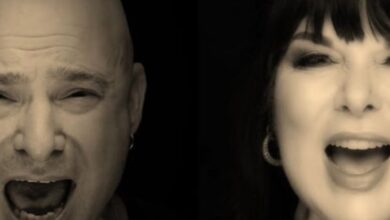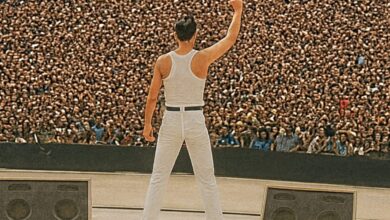Metal Vocal Power Turns “O Holy Night” Into an Unforgettable Anthem
The first thing that set this performance apart was intent. Rather than offering a cheeky or throwaway “metal Christmas” gimmick, Dan Vasc approached “O Holy Night” with the grandeur of a power-ballad epic, staying faithful to its sacred heart while lifting its drama into a larger-than-life rock atmosphere. The timing of its release also played a role: fans first experienced it as a striking music video in December 2023, letting the emotional imagery guide their first impressions, and only later through the polished audio single available on streaming services. The two-stage rollout helped shape a collective perception that this wasn’t just a holiday experiment but a bold and sincere artistic statement, one designed to be replayed long after the tree lights dimmed.
Listen closely and you can hear the quiet-to-thunderous storytelling design that defines the performance. In the opening verses, Vasc’s vocal remains reverent, almost prayerlike, leaning into clarity and phrasing to preserve the hymn’s centuries-old elegance. But as the arrangement swells toward the chorus, the sound transforms—electric guitars enter like a rising storm, drums build tension through measured accents, and dynamic orchestration broadens the harmonic sky above the melody. By the time he reaches the powerful line “A thrill of hope,” the track is already operating at the emotional level of an arena rock finale. It’s a dramatic growth curve that turns contemplation into exultation the way only metal truly can.
A key part of that success is the balance between heavy instrumentation and open-air vocal space. Dan Vasc’s voice sits dead center, commanding the arrangement without smothering the hymn. The mix emphasizes breath, diction, and a clean yet heroic tone that keeps the performance rooted in tradition, even while the guitars crunch underneath. Rather than leaning into aggressive distortion or harsh delivery, he opts for a soaring clarity that reassures listeners that this metal version still treats the song as sacred. It becomes clear quickly that the metal tools are being used not to rebel against holiness—but to amplify it.
Production details further support that vision. The arrangement builds layer upon layer: pianos sketch the harmonic foundation, strings heighten the emotional arcs, and guitars inject modern power into the structure. Every measure seems designed to grow either in weight or in meaning, pulling the listener through a cinematic holiday journey. The drums, while bold, never overpower the spiritual undertones—they line the edges of the sound like cathedral pillars, enabling the voice and orchestra to shine like stained glass flooded with light. That mindful craft is what makes the performance feel devotional rather than destructive.
Timing also placed the track in a prime spot within the holiday listening calendar. Released just days before Christmas, the video quickly resonated with fans scrolling for seasonal emotion, while the subsequent single release in early January allowed for a second burst of discovery. Those who stumbled across it after the holiday rush found its power refreshing, a reminder that some Christmas music doesn’t expire the moment the date changes. The project was built to have an afterlife—and it does, easily sliding back into rotation each winter as if it were part of the classic canon.
Vocally, this is one of Vasc’s most technically accomplished performances. His mid-range storytelling transitions seamlessly into higher belts that feel effortless despite their obvious athletic difficulty. The climactic sustain in the final chorus is a moment engineered for goosebumps, executed with strong breath support and controlled grit that never crosses into harshness. Even vocal coaches reacting online pointed out how the emotional weight of his delivery matches the physical strength needed to maintain such long phrases. It’s the kind of singing that gives believers chills—and causes metal fans to pump their fists in solidarity.
The structure of the performance serves the lyric’s core message. Instead of rewriting or modernizing any part of the text, the song leans into the hymn’s original poetry, letting the metallic force behind it underline its themes. The call for the world to “rejoice” arrives married to a triumphant crash of percussion; the plea to “fall on your knees” is delivered with an almost operatic intensity that feels like a spotlight from heaven slicing through a clouded sky. You feel the message physically in the swell of sound, proving that metal can communicate reverence every bit as effectively as a choir.
Fan responses showcased how strongly the music connected across communities. Many listeners expressed surprise that a metal rendition of a sacred carol could feel so uplifting rather than irreverent. Others praised the emotional sincerity, remarking that this interpretation made the famous lyrics resonate like new. It wasn’t just a niche success—people who ordinarily stick to traditional choral recordings found themselves replaying this version because it awakened a sense of awe without asking them to compromise their holiday mood. Metalheads, meanwhile, appreciated hearing their genre associated with something transcendent and affirming.
Part of this crossover appeal is that Vasc has cultivated a consistent artistic identity: taking beloved songs—especially those with deep emotional grounding—and reimagining them in ways that elevate the experience rather than parodying it. Fans familiar with his previous hymn adaptations were already primed to take him seriously when he approached Christmas repertoire. This trust is what allowed “O Holy Night” to avoid the common fate of novelty metal: listeners embraced it not as a joke but as a powerful seasonal masterpiece.
The collaboration behind the arrangement is also important. Instead of a one-man stunt, the track feels like the result of shared musical vision. The orchestral elements, the crystalline pianos, the tightly controlled rhythm section—all of it suggests careful teamwork rather than last-second holiday enthusiasm. Even the music video’s polished look communicates professional respect for the source material. It’s a performance meant to be experienced like a major release, not a one-off YouTube upload.
What’s more, the decision to treat this hymn like a stadium ballad opened the door for visually arresting moments in the video. Each cut, backdrop, and lighting shift seems timed to the song’s structural peaks. The dynamic control of imagery elevates the emotional impact: when the song asks the world to “hear the angel voices,” the visuals feel just as heavenly as the sound. It’s Christmas spectacle done without kitsch—bold enough for a metal audience, beautiful enough for holiday purists.
The song also engages with a growing cultural appetite for serious, epic Christmas music. As modern production tools evolve, listeners crave versions of traditional hymns that feel cinematic without losing spiritual intimacy. That is the tightrope this track walks masterfully. It doesn’t wink at the camera or lean into irony; it steps into the emotional space with full sincerity, trusting that the scale of holiday belief deserves an equally enormous soundtrack.
From a longevity perspective, “O Holy Night” was built to endure. Seasonal music lives or dies by whether listeners are excited to return to it each year. Because this track blends a timeless melody with high-quality metal energy, it offers something fresh to repeat annually. It stands out within playlists crowded by soft pop, jazz, and choral renditions—an anthem for listeners who want goosebumps bigger than twinkling lights.
The audience response continued to expand as vocalists, musicians, and reactors across YouTube discovered it and praised both the technical excellence and emotional sincerity. These organic second-wave reactions often become the engine that keeps a holiday release alive long after its debut, and this one shows no sign of slowing. The more people share it, the more it becomes woven into their personal Christmas rituals.
And then, when the final note lands, it doesn’t feel like a singer showing off. It feels like a moment of spiritual triumph, a proclamation of joy amplified through amps and drum kits rather than organ pipes. That is why this version continues to move people—it respects the heart of the hymn while letting metal express awe in a way only metal knows how. Every December, when people search for something that feels both sacred and electrifying, this performance answers the call.
Dan Vasc’s reputation for succeeding where others hesitate also comes from his ability to take on monumental songs from history—like his acclaimed metal version of “Amazing Grace.” That cover demonstrated early on that he wasn’t afraid to approach deeply spiritual music with the emotional conviction it deserves. Listeners praised how he honored the song’s message of redemption while transforming it into an uplifting, fiercely triumphant anthem that sounds like a battle cry for hope. The success of “Amazing Grace” proved that sacred texts could find new power in metal form, and it laid the emotional foundation for audiences to fully embrace “O Holy Night” as a legitimate expression of reverence rather than a novelty reinterpretation.
Similarly, his reimagining of “The Sound of Silence” showcased his skill in bridging genres with respect and dramatic flair. By taking a haunting folk ballad and swelling it into a grand rock spectacle, he captured the tension between solitude and awakening embedded in the lyrics. Fans who discovered that performance realized Vasc could amplify a song’s emotional extremes without diluting its meaning. That set a precedent: when Dan Vasc covers something iconic—whether sacred, poetic, or historical—listeners expect to be both moved and surprised. Together, “Amazing Grace,” “The Sound of Silence,” and now “O Holy Night” form a trilogy of transformations that highlight his unique talent for making familiar songs feel not just new, but transcendent.





